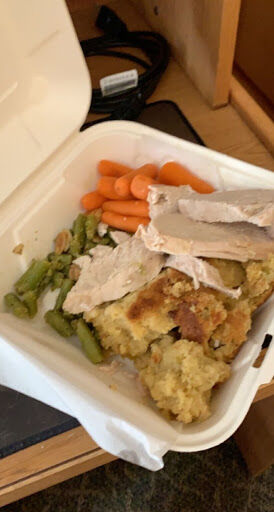Student’s self-isolation proves to be full of ups and downs
December 9, 2020
While working out at the gym, a friend sent me a text.
“Just tested positive.”
Right after the text, a 330-number called me. The Kent State COVID-response team had seven dreaded words for me.
“You have to quarantine for two weeks.”
I had tried to be as cautious as possible, avoiding large gatherings and parties, wearing a mask whenever I was in public, but I knew it would happen to me eventually. Living in a dorm on a college campus meant eventually I would come in contact with someone who got coronavirus, so I had mentally prepared for a quarantine.
I called my parents after talking to the response team. In the interest of my mom’s teaching and my sibling’s schooling, I decided to quarantine on campus. One night for about an hour I was in contact with my friend who had tested positive. When I hung out with them it was during the 48-hour period that they tested positive, so I thought there was no chance that I would test positive in quarantine.
My biggest fear wasn’t what would happen to me, but the people around me. My roommate was interacting with people who were at risk.
When I was making calls to family and friends, I got reactions ranging from “I hope you are doing well” to grunts.
I was given about an hour and a half to pack all the things in my dorm I would need. With some clothes and my computer ready to go, I bussed to Centennial F. My dorm was clean, but that was not the case for some other people.
“I found dirty towels and empty water bottles, something I was not supposed to find in a clean room,” said sophomore public relations major Morgan Cummings.
My biggest complaint with quarantine was the food. I tried to reach out to a Kent State employee who oversaw students going into quarantine, but she did not respond to my interview request about her involvement with the process.
The next morning, I got tested at the KIVA. My worst fear was realized, I tested positive. I sat down with the COVID response team. They told me I would be moving to isolation in Van Campen Hall, a place I had never seen. I had to provide them a list of contacts with whom I was in contact with for the past 48 hours. Luckily, it was only my roommate whose phone number I had to give to the team. For the second time in two days, I packed up all my belongings and was bussed to another dorm.
When I arrived at Van Campen, I was emailed a grocery list. The options were not great, but I thought the food would be better than the pre-packaged meals being delivered to me already.
After my first delivery the meals stopped coming, and I had to rely on my grocery order to provide my meals. I might not have read a rule somewhere that described this, but I felt living off this grocery order was not the most viable of options.
I would see residents from time to time, but I never had any close contact with any of them. The doors were very loud, so I would know when people were moving in or out, but I tried to stay away from people.
My classes went smoothly because they were already all online. My main problem was my mental health, a huge problem already among students in quarantine. Now that I was completely self-isolated, it was going to be a big challenge. Several family members called in to check on me, which helped. I was even sent a gallon of cold brew coffee by my parents to get me through the week and a half.
I could tell my own mood was decreasing, but my family members say I took a turn for the worse especially around the seventh and eighth days of quarantine. I stopped responding to anyone and closed myself off.
“(Ben) is normally very even keeled and upbeat,” my dad Michael Vrobel said, “but he had some pretty serious mood swings during quarantine.”
In the last few days of quarantine, only one health organization called me. The only organization was the Portage County Health Department. They asked if I was continuing my quarantine. I expected some sort of correspondence from the Kent State COVID response team during quarantine, but I had to call them to let them know I was out of quarantine. No one enforced my quarantine.
When I left isolation, there was nothing I had to fill out or tell anyone on site. I just packed up my belongings and had a friend help me back to my dorm.
From my experience, Kent did an alright job of keeping students safe through isolation. I followed all the correct procedures, and I was the only person in my contact trace to contract coronavirus. I think the biggest problem is students’ cooperation with the program. The university has open testing in the KIVA, and if people know where to find it, they can get tested the day they get symptoms.
My friend and I are both coronavirus-free, and we agreed that we never want to quarantine ever again.
Ben Vrobel covers administration. Contact him at [email protected].
SUPPORT STUDENT MEDIA
Hi, I’m Lauren Sasala, a senior journalism student from Toledo. I’m also the editor in chief of The Kent Stater and KentWired this semester. My staff and I are committed to bringing you the most important news about Kent State and the Kent community. We are full-time students and hard-working journalists. While we get support from the student media fee and earned revenue such as advertising, both of those continue to decline. Your generous gift of any amount will help enhance our student experience as we grow into working professionals. Please go here to donate.

























